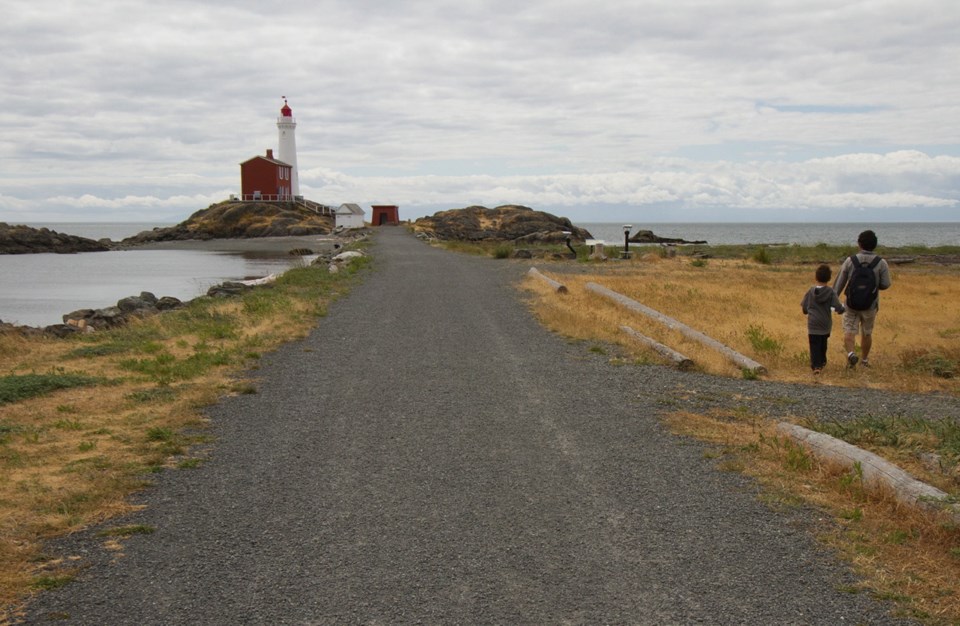‘It’s strange how some people can walk the same route every week and not know about what’s happening around them,” Nature Boy said. We’d gone for a hike in one of the region’s parks and a friend asked about “the yellow flower.”
Nature Boy couldn’t answer — there were too many options. His response: “Computing … Computing … Insufficient data …”
A trailside example was found. The yellow flower turned out to be the dense yellow blooms of the Oregon grape, a spiny-leafed evergreen shrub. Other possibilities in Nature Boy’s mental encyclopedia for the time of year had included, for example, spring gold and buttercup.
On a different walk a few weeks ago, up Mount Douglas’s north slope, someone asked about “the white flower.”
Fawn lily was an obvious response, because it was still blooming lavishly. But, “No, I know what those look like and that’s not it.” After more information was supplied, the mystery flower turned out to be trillium.
Not everybody is engrossed with the natural world and tracks its unfolding through the year. They’re busy. They’re focused on other things. They also have their own areas of expertise.
Or their mental hard drives might be too full with other, more vital information.
In addition, wildflowers bloom for just a few weeks, butterflies flutter by for a month or two and most birds hang about for only half the year. The names of the obvious, common species stick, but information about the rest can easily be overwritten by more pressing details.
Every spring is an opportunity to become reacquainted with these old friends. The off-key harmonics of the varied thrush, the squeaky-hinge call of the spotted towhee and the operatic trills of the Pacific wren add variety to the garden-variety calls from the garden. Shooting stars and satin flowers, spring gold and yellow monkey flowers, blue-eyed Mary and blue-eyed grass take their turns in the region’s meadows and forests, where celebrity wildflowers such as camas tend to claim the spotlight.
Even if you can’t draw on Nature Boy’s expertise, you can head out into the woods today with other walking nature encyclopedias. Capital Regional District parks and Swan Lake Nature Sanctuary schedule naturalist-guided hikes and walks throughout the season. On just one day each year, the Nature Conservancy of Canada holds the In Bloom Wildflower Festival at the Cowichan Garry Oak Preserve on Maple Mountain, west of Duncan, inviting the public to visit and tour the sanctuary with site staff and wildlife researchers.
The 2019 event took place on Saturday, but if you missed it, the Nature Conservancy of Canada hosts drop-in volunteer opportunities on Wednesday mornings to help at the site.
Mobile apps can also help identify the region’s birds and buds. For example, Song Sleuth, ChirpOMatic, BirdGenie and Bird Song ID use Shazam-like tech to identify birdsong. Record the birdsong in question via the apps and they will identify the species, based on season and location.
Wildflower and other plant apps and online sites tend to require more work on users’ part. E-Flora B.C. is a web- and GIS-based biogeographic atlas that lets you search by species or common name, genus, family or photo. When you give the B.C. Wildflowers app information about a plant’s location, flower colour and the time of year, it will shortlist the plants that fit the description. The Washington Wildflowers app provides images, species descriptions, range maps, bloom period and technical descriptions for 870 common wildflowers, shrubs and vines found in Washington and southern B.C.
For trees, the UBC Botanical Garden’s app, Vancouver Trees, describes commonly cultivated trees in the Metro Vancouver area, but works on the south Island. Leafsnap is a series of electronic field guides to visually identify trees from photos of their leaves.
Which apps do I have on my phone? I don’t, because I have Nature Boy. And if I don’t provide enough information, I, too, get: “Computing … Computing … Insufficient data …”



